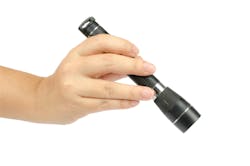Bone Cement and Black Light Detection - Part 1
Q: “Recently, I read a posting on the Internet that one can use black lights to detect residual bone cement. Is this true,1 and could our department use a black light for this purpose?”
A:
We all have watched forensics crime television shows where they use a “black light” to find blood and other substances. It must work for detecting bone cement, right? “Under the black light, substances not seen by the human eye may be visible.”2 Bone cement is hard for us to see, too, so we all want an easy tool to detect any residual residue. I read it on the Internet, so is it okay to use….?
Posts I see online do not provide clinically relevant evidence to back up this black light inspection method, nor are they sharing their policies about how to use the black light. Not saying it is not a useful tool for this purpose, but I do not see the same critical thinking used for other methods also being applied to this “black light method.”
As with anything, one must understand the tool to be used. Long ago, my mother, Irene, often reminded me to remember the 5 W’s (who, what, where, when, and why) and one H (how) when you do something.
If the black light shows something glowing on the medical device, what does it really mean? Better yet, what does a black light show when it is waved over the item?
What you see glowing under the black light is fluorescence. Whether it is your T-shirt, a poster, or maybe a medical device, the object must have some type of phosphor to show up and glow. Thus, what we are talking about is understanding fluorescence, and whether or not it can be applied to finding bone cement left on medical devices.3,4
UV-A, which is also called "black light" or "Long Wave" UV, spans wavelengths between 320 and 400 nm. Here are some questions I would like to raise.
- Is there a specific wavelength we need within this spectrum to pick up bone cement?
- Must the work area where we are inspecting have certain illumination?
- Does background light have a direct or indirect impact on what we see?
- If no bone cement is detected, how do you confirm that?
- What is the detection limit?
Next, I know of at least four types of bone cement. Does it work on all of them? We know that if a substance contains phosphor, then a black light should pick it up, but how much phosphor do you need for it to be detected?
The next set of questions is based on bone cement. Does bone cement:
- Contain enough phosphor (or other radiopaque material) to be detected by a black light?
- Need a specific wavelength?
- Have a minimum detection limit and at what wavelength?
Plus, we need to ask:
- Is 1.0 µ of phosphors detectable?
- What is the lowest level that is safe?
We also need to examine the word “cement,” as it “is a misnomer. The word cement is used to describe a substance that bonds two things together. However, …” in orthopedic surgery procedures, these substances “… act as a space-filler that creates a tight space which holds the implant against the bone and thus acts as a ‘grout’.”5 For this article, we will use the term “bone cement,” which we all are accustomed to.
There are many different commercially available bone cements (polymethyl methacrylate (PMMA), calcium phosphate cements (CPCs), and glass polyalkenoate (ionomer) cements (GPCs)). Many of these bone cements also have barium sulphate (BaSO4) or zirconium dioxide (ZrO2) in the bone cement, which are a radiopaque material. These types of commercially available bone cement are successfully used in orthopedic and dental applications. The problem is that some cement gets left behind on the medical devices, and it is difficult to detect and clean off. The question is: Could a black light pick up that residual bone cement if left on the medical device? In a month, as the late American Radio Broadcaster Paul Harvey would say, “… the rest of the story,”6 in part 2!
References:
1. Jagrosse, D. (2023, February). Are you using a black light on SPD Instrument assembly to look for residual bone cement? Thoughts? Outcomes? [Image attached] [Post]. LinkedIn. https://www.linkedin.com/posts/jongoodwin3_apa2019-activity-6569581103441682432-CN98
2. Brenner, L. (2018, April 26). What Kind of Invisible Stains Do Black Lights Detect? Sciencing. https://sciencing.com/kind-stains-black-lights-detect-5045775.html
3. Harris, T. (n.d. Updated: 2021, May 10). How Black Lights Work. HowStuffWorks. https://science.howstuffworks.com/innovation/everyday-innovations/black-light.htm
4. Pratt, A. (n.d.). What Is a Black Light Inspection? Sciencing. https://sciencing.com/facts-5629929-black-light-inspection-.html
5. Vaishya, R., Chauhan, M., Vaish, A. (2013, December 16). Bone cement. Journal of Clinical Orthopaedics and Trauma, 4(4), 157–163. doi: https://doi.org/10.1016/j.jcot.2013.11.005
6. Jones, C. D., (2002). What Paul Harvey Used to Say, and Why We Say It Again. Callaway-Jones. https://callawayjones.com/restofthestory/
About the Author

Stephen M. Kovach
Stephen M Kovach, BS, CFER, started in the medical field in 1975 as a sterilization orderly and has worked in many positions within the Healthcare Industry. He presently is Clinical Educator Emeritus at Healthmark, A Getinge company.
